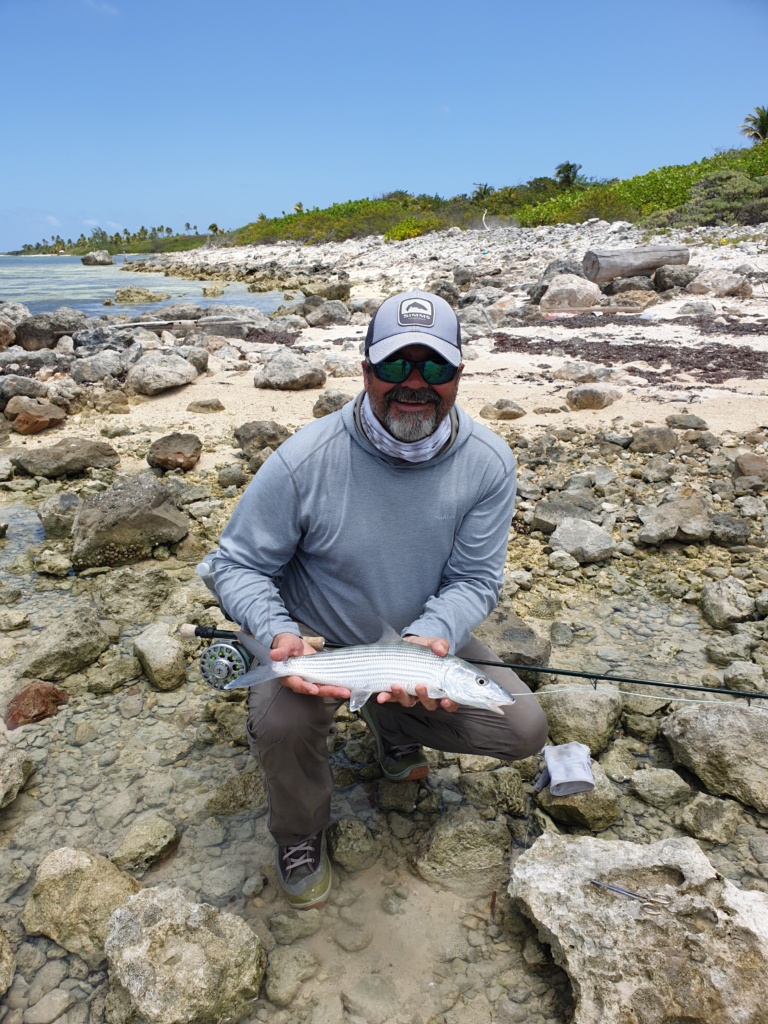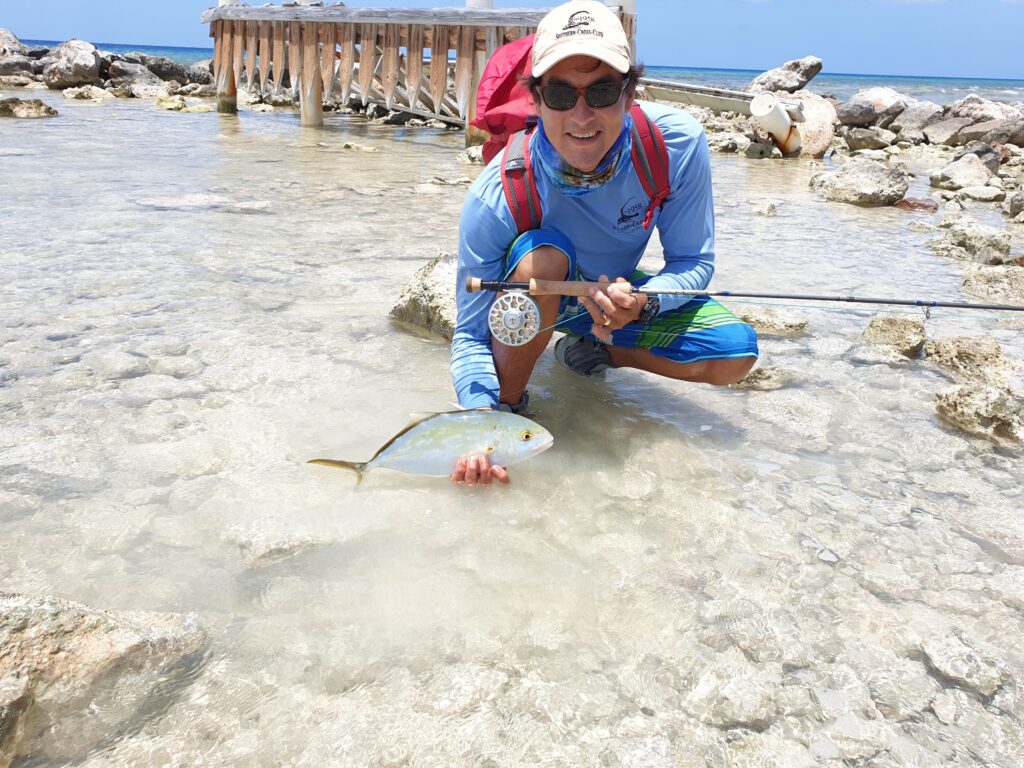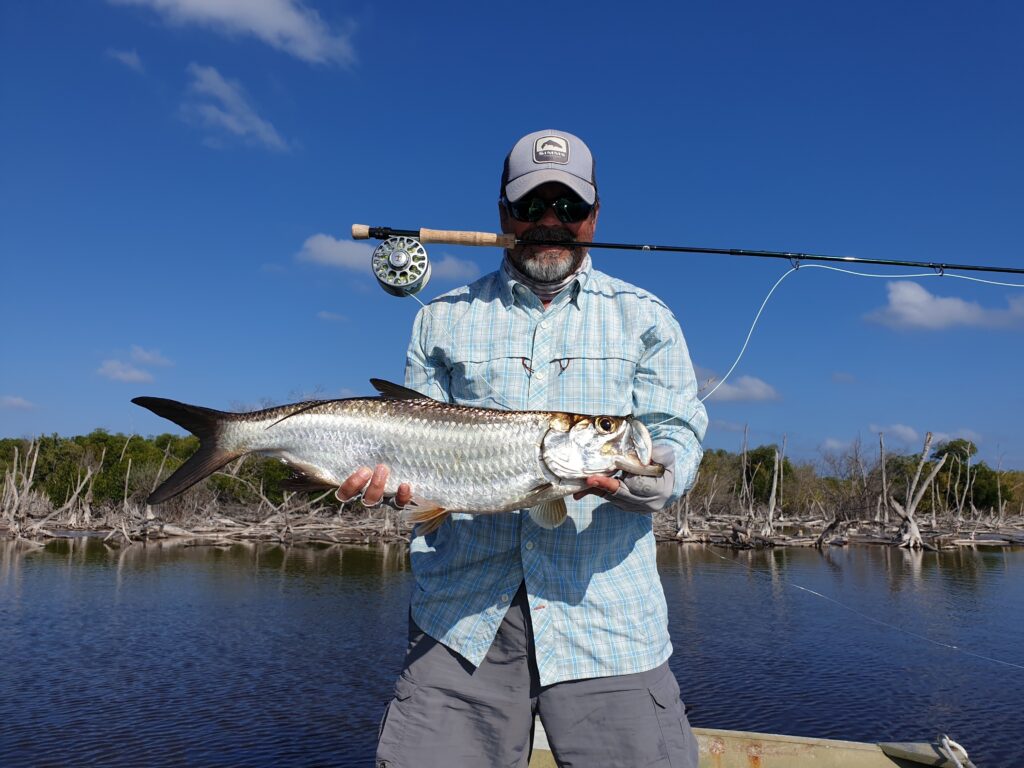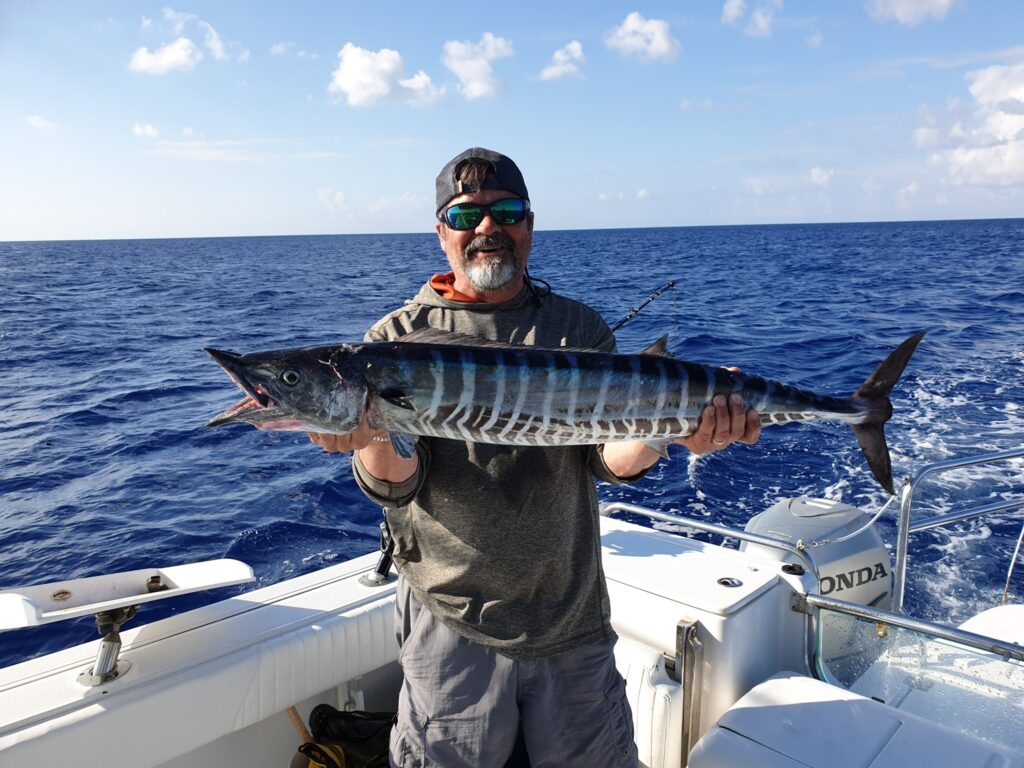I seek out places where I can combine my love of fishing with other activities. I am married to a very understanding woman, but there are limits. Luckily Kathy likes sailing, and scuba diving, so tropical adventures where I can combine fishing with one of these other past-times is not too hard to find. One of the places that strike a balance in this regard is Little Cayman Island. This place is incredible with its quiet, laid-back lifestyle, unbelievable diving, and some pretty good fishing to boot.
Little Cayman is the smallest of the Cayman Islands lying 60 miles west of the more popular, and very crowded, Grand Cayman Island. Little Cayman is about 10 miles long with an average width of about 1 mile extending from West to East with the windward south-side of the island populated with resorts and residences. The island is uncrowded with a couple of resorts, an airstrip that you fly into on a Dehavilland Twin Otter turboprop aircraft, a couple of restaurants, one convenience store, one fire station, and one policeman that I saw once in a week’s stay there. You quickly slide into a free and easy flip-flop and t-shirt mood, firstly because it is so luxuriously pleasant weather-wise, and secondly because there is such convenience in getting to any activity that you want. The world-class diving or great offshore fishing is a short boat ride away. If you’re going to snorkel or patrol the flats for fish, you can kayak from the resort, or take a bike or scooter down the road to coral rubble beaches that you’ll have to yourself. If you elect the scooter as transport, there are only a few risks to consider. Firstly, you have to remember to drive on the other side of the road, as it is a British Island. Sounds easy, but then there is so little traffic at times that you forget and find yourself beak to beak with the odd vehicle. Secondly, you have to be mindful of the occasional Rock Iguana or Hermit Crab crossing the road. The Rock Iguanas move out of your way while the Hermit Crabs don’t. Throw a sandwich, some drinks, and fly tackle into a backpack, and the adventure begins.
Before I start talking fishing, I should speak to SCUBA diving, which is the real claim-to-fame of this place. The Bloody Bay Wall that is on the opposite side of the island from the resort, is the best diving I’ve experienced in the Caribbean. We encountered gin-clear waters, plenty of turtles and reef fish, minimal current, and jaw-dropping underwater canyons and cliffs that plunged into the deep blue. You can typically dive two dives in a morning and have the afternoon for fishing. What’s not to love about this place.
On the afternoon of the first day, I found myself with a couple of free hours after the morning diving and threw a flyrod, a fanny pack with flies, and my wading boots into a kayak. My destination was a little sliver of mangrove, known as Owens Island, across from the Southern Cross Club resort where I was staying. The island stretched across the lagoon toward the fringing reef, with the inshore end of the isle presenting a delightful sandy beach that had attracted a couple of sunbathers. I was more interested in the outer point of the island that terminated in ragged razor-sharp coral iron-shore that formed a channel between the island and offshore fringing reef. This channel seemed a likely spot for predatory fish in my mind. I found no bonefish there but rather an assortment of reef fishes with many small mutton snappers and bar jacks falling prey to my Gotcha fly. At one point, I saw a sizable barracuda cruise down the channel, but I had the wrong tackle for him. In about 1 hour, I had landed an assortment of fishes, but none of them heavier than about a pound. Catching these smaller fish was great sport, but had me wondering as to whether there were better places just around the corner, or perhaps bonefish down near the beach-end of the island. I paddled the kayak around the shallows of the island, found nothing on the flats, and headed back toward the resort. In the deeper water of the grass flats, I saw fleeting glimpses of larger quick-moving shapes that darted away from my kayak, making me wonder as to what species they were. It didn’t make sense throwing a fly at them in their flight. You have to see the fish before he sees you, and on this deep grass flat, that was tricky. I still wonder as to how to attack such a situation with a flyrod.
A couple of days later, I arranged to fish a half-day on the flats with the guide from the Southern Cross Club, Patrick Gough. He is a lean, tanned, dark-haired young man that I am guessing is in his late twenties. In talking with him, I find he is originally from Roatan Honduras, another great destination in my estimation, similar to this island. He and his wife work on this more affluent island to make ends meet and provide for a future for their young daughter. Most of the residents of the island are ex-pat workers, like Patrick, looking to improve their lot in life away from their origins. I am surprised at our transport to the flats, as Patrick walks me to a beat-up truck. We throw the fishing gear in the back and head down the road to the east end of the island. No flats boats needed here. I am starting to realize that a guide is not necessarily required for flats fishing in Little Cayman but maybe makes sense for my first trip. My thinking is confirmed later when talking to a veteran guest who is also a fly fisherman. Patrick parks at a turn in the road near the tip of the island, and we clamber down a slight slope covered in sea-grapes, to the aquamarine waters of the coral rubble beach. We are fishing the lee side of the island near Bloody Bay Wall with the dive boats parked out on the reef, not a 1/2 mile out from us. Patrick puts us on bonefish at the outset. After a couple of spooked fish, I finally connect with a small bone that puts up a good scrap. While I am targeting bones with my 8 wt rod, I have Patrick carrying my 7 wt rod as a backup. At one point, while we are both fishing, he tags a nice bar jack on the 7 wt and has a great time fighting this fish.


Patrick and the Bar Jack
The bonefish I encountered in Little Cayman were like those I have fished for in Belize, smaller than the Bahamas or Florida bonefish but scrappier in my estimation pound-for-pound. Like Belize, the fish push into shallow water, so one needs to carry an assortment of different weighted smaller #6 or #8 shrimp type flies like the Gotcha or crab imitations like the Bonefish Bitter. You bring your own terminal tackle to Little Cayman. There is no place to buy flies on the island, and Patrick has a limited capability for fly-tying due to his difficulty in getting materials. In fact, as part of my tip to Patrick, I loaded him up with about a third of my fly box. He earned it. Tackle isn’t the only thing scarce on the island. I lost one of my flip-flops and couldn’t find a replacement anywhere on the island, having to wear my crocs for the duration.
One evening I had Patrick take me out to the Tarpon Pond, a landlocked saltwater marsh of tannic brown water with fields of whitened dead trees protruding up within it. A break in the mangroves along a nondescript section of the coast road was all that defined the entry to Tarpon Pond. A short walk through this green gate led to a long wooden dock in a shallow lagoon. Tied to the dock was our ride, a rowboat. I was surprised and a little dismayed at the thought of us trying to trundle around the large expanse of the inland lake in this way. We loaded our gear in the boat. No sooner had my guide covered 50 yards to the first point of deadfall trees than we saw a commotion of white egrets shrieking and diving at a corner of water in the lagoon some 100 ft away. Patrick excitedly confirmed that it was a school of tarpon feeding. I stood awkwardly in our slightly unstable vessel. My first cast of the day presented a rust-brown cockroach fly to the edge of the churn. After a couple of long strips, the line hesitated as if caught on some unseen structure, and then arced toward the rowboat.
I frantically stripped line in to get in contact with the suspect fish as the arc of flyline passed to the stern of the rowboat toward deeper water. Finally, I was fast to the fish, and he immediately responded with a somersault into the air, 3 ft clear of the water. Somehow I managed to clear the nest of flyline from the sole of the rowboat and onto the flyreel. On reflection, I can’t say how I achieved that miracle A long, enthralling fight ensued with mind-blowing aerobatics, the whir of the reel drag from the fish’s runs, and flashes of gold in the brown water. Finally landed, he was a beautiful fish with those oversized eyes and scales as compared to other fishes, and with a distinctly brown back to match the water of his home. He had taken the fly deep. We couldn’t get it out without taking a lot of time or severely damaging the fish’s gills, so we cut the line at the hook and let him swim on, hoping the hook would rust out and not ultimately be a mortal wound to the fish. A bittersweet end, I thought, to a stunning victory, and all within the first 15 minutes of fishing here.
The feeding frenzy had died down, and now we were relegated to chasing the occasional bubble trail or swirl in the tea brown water or blind-casting to likely hold spots based on the structure. Still, I connected with two more fish, which I promptly lost when they went aerobatic. Patrick hooked and lost one, also on my spare 7 wt rod. A fine evening.

Two days later, I had the good fortune to share an offshore charter with another diver. Patrick, the multi-talented guide, was at the helm of a seaworthy Glacier Bay power catamaran with dual outboard motors. It seemed a small boat for fishing offshore but was up to the task since we went out through the reef and very shortly turned the corner to the lee-side of the island where the seas were more kind to us. Amidst the deep blue water off of Bloody Bay Marine Park, we connected with a nice Wahoo while trolling at a brisk 10 Knots. This rocket of a fish was my first wahoo, a good fight but a surprisingly short one, perhaps because of the heavy-duty tackle I was using. I guess you never know what will hit a big trolled bait out there. Had it been a marlin or big tuna, it would have been a different story. The wahoo was a beautiful fish by any measure. My buddy, Dr. Diver Dan, and I celebrated with cigars and rum, on top of the beers we had already consumed, and weaved down the dock afterward in happy celebration. The wahoo made for a nice dinner for the entire resort the next night, cooked to perfection by the Indian head chef.

I am inclined to share one anecdote as evidence of the languorous time that you can find yourself enjoying here. Kathy and I were having a leisurely lunch at the Hungry Iguana Restaraunt, a small place, with good food, on the western end of the island near the airstrip. It overlooks the windward fringing reef with spectacular views of the lagoon that is sprinkled with coral heads. While sipping my beer on the outdoor deck in the shade of an awning, I start to notice a pattern in the bird activity to our front. A single whitish-grey bird, which I found out earlier, was the red-footed booby, would fly out from the shore to just outside the reef and dive into the water for fish. Once airborne, the booby would be immediately set upon by several frigate birds with their stiletto black wings and rapier beaks. They would savage the white bird, until the booby would cough up his catch, with one of the frigate birds grabbing it in midair and devouring it himself. I watched in amused horror, wondering as to how the boobies were to ever feed their fledglings in the rookery of the Booby Pond just down the road. Then I saw the answer. After a couple of single boobies went out and found the fish, and suffered the depredations of the frigate birds, there suddenly appeared a full squadron of boobies that came out to dive-bomb the bait en masse, overwhelming the ability of the frigate birds to mob any single member. Much like a flight of B-17 bombers fending off german Focke-Wulf fighters. I wonder as to how these scouts communicate the presence of baitfish to the rest of the rookery and orchestrate a mass attack, or more importantly, how the flock picks the sucker who gets beat up by the frigate birds first? Perhaps another beer will shed some light on the subject. It takes a while to discern the unfolding subtleties of such drama, but in Little Cayman, you have the time.
